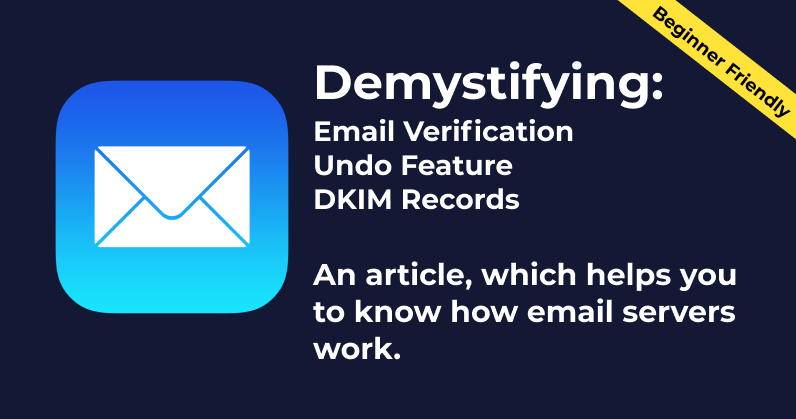In the age of digital communication, email remains a cornerstone of professional and personal interactions. However, it's not immune to challenges, including spam, phishing, and fraudulent activities. This is where email verification steps in as a crucial tool to ensure that your inbox remains a secure and trustworthy space. As an expert in the field, I'll guide you through the inner workings of email verification and its pivotal role in safeguarding your email experience.
What is Email Verification?
Email verification, in its essence, is the process of confirming the validity and authenticity of an email address. It serves as a gatekeeper, determining whether an email address is deliverable, active, and owned by the user who claims it. While the concept may seem straightforward, the underlying mechanisms are more intricate than you might think.
How Does Email Verification Work?
1. Syntax Check
The process begins with a syntax check. This initial step examines whether the email address follows the standard format, including an "@" symbol and a valid domain name. If an email address fails this basic test, it's considered invalid and won't proceed further.
2. Domain Check
The domain check is a critical phase of email verification. It involves querying the domain's DNS (Domain Name System) records to verify if the domain exists and is configured to accept emails. If the domain is invalid or unresponsive, the email address is flagged as problematic.
3. MX Record Check
MX (Mail Exchange) records specify the mail servers responsible for receiving emails on behalf of a domain. Email verification services check the MX records to ensure they are properly configured and reachable. If not, it suggests that the domain may not be capable of receiving emails.
4. SMTP Check
SMTP (Simple Mail Transfer Protocol) is the standard for sending and receiving emails. In this step, the email verifier simulates an SMTP handshake with the recipient mail server to validate its responsiveness. If the server does not respond or returns an error, the email address is considered undeliverable.
5. Disposable Email Check
Disposable email addresses are temporary and often used for one-time purposes. Email verification tools maintain a database of known disposable email domains and flag email addresses associated with them. This helps filter out temporary or potentially fraudulent email addresses.
6. Role-Based Email Check
Role-based email addresses are generic addresses associated with roles or departments (e.g., [email protected]). While these can be legitimate, they are often targeted by spammers. Email verification identifies and categorizes role-based emails.
7. SMTP Check
SMTP (Simple Mail Transfer Protocol) is the standard for sending and receiving emails. In this step, the email verifier simulates an SMTP handshake with the recipient mail server to validate its responsiveness. If the server does not respond or returns an error, the email address is considered undeliverable.
8. Syntax Check
The process begins with a syntax check. This initial step examines whether the email address follows the standard format, including an "@" symbol and a valid domain name. If an email address fails this basic test, it's considered invalid and won't proceed further.
The Importance of Email Verification
Email verification is not just a technical process; it's a safeguard against a myriad of email-related issues. Let's explore why it's so crucial:
1. Reducing Bounce Rates
Invalid or undeliverable email addresses result in bounced emails, negatively affecting sender reputation and email deliverability. Email verification helps reduce bounce rates, ensuring your messages reach the intended recipients.
2. Preventing Fraud and Spam
Fraudulent and spammy accounts often use invalid or temporary email addresses. By filtering out such addresses, email verification minimizes the risk of phishing attacks, scams, and unwanted spam in your inbox.
3. Enhancing Deliverability
Email verification improves your sender reputation by reducing the likelihood of sending emails to non-existent or inactive addresses. This, in turn, increases the chances of your emails landing in the recipients' inboxes.
4. Saving Time and Resources
Sending emails to invalid or unresponsive addresses wastes valuable resources and can damage your sender reputation. Email verification helps you focus your efforts on engaged and genuine recipients.
Frequently Asked Questions
Let's address some commonly asked questions about email verification:
Q1: Do I need to manually verify every email address I send an email to?
A1: No, you don't. Email verification services can automate the process, allowing you to validate email addresses in bulk or in real-time as you collect them.
Q2: Are there free email verification tools available?
A2: Yes, some free email verification tools exist, but they may have limitations in terms of the number of checks and accuracy. Paid services often provide more comprehensive and reliable results.
Q3: Can email verification tools identify disposable email addresses accurately?
A3: Yes, most reputable email verification tools maintain databases of known disposable email domains and can accurately flag such addresses.
Q4: Is email verification GDPR-compliant?
A4: Yes, email verification can be conducted in compliance with GDPR (General Data Protection Regulation) guidelines, provided you obtain consent from users and handle their data responsibly.
In conclusion, email verification plays a pivotal role in maintaining the integrity of your inbox and ensuring efficient email communication. By understanding how it works and leveraging its capabilities, you can protect yourself from spam, fraud, and wasted resources while enjoying a smoother email experience.



